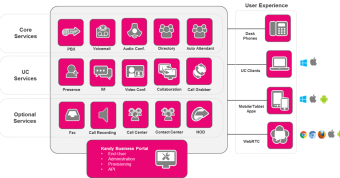ARPU growth via Enhanced Narrowband Services (ENS): Connecting the Island to Mainland
Narrowband? Who is talking narrowband or TDM these days? When it comes to narrowband voice services over the last two decades, there has been little to talk about. ARPU declined as toll revenues disappeared, and revenue has been declining as voice lines continue to decline.
As a result of these declines, the thought that “Narrowband is bad and broadband and SIP are good” is not often spoken, but it is sometimes implied. Narrowband gets a bad rap, not because it doesn’t transmit voice properly, but because it is an island (a very big island) – not linked to the exciting new, albeit small, SIP mainland. But what if Narrowband could become SIP-capable and be easily integrated into the umbrella of SIP services? GENBAND’s Enhanced Narrowband Services (ENS) solution enables this, changing the definition of Narrowband forever and making ARPU growth a reality.
Before we talk ENS, however, let’s first talk about telco sales models. Most sales come via inbound calls to the Business Office, where reps have various responsibilities like selling features and bundles or answering billing questions. In general, this has been a very successful model. It is non-disruptive, meaning you do not typically move the customer away from their basic, underlying service since doing so might prompt them to consider competitive alternatives. It is also additive, meaning that you try to convert every inbound call into an opportunity to sell additional services.
Let’s also talk about industry dynamics. The U.S. is experiencing roughly 10% annual voice line loss – but this loss is not the same for consumers and businesses. Consumers can more easily substitute Plain Old Telephone Service or POTS for mobile or other alternatives – but businesses often cannot, for a variety of reasons. GENBAND looked at these line-loss dynamics for the largest North American providers and extrapolated data out to the year 2020. The numbers speak for themselves – business lines are moving to the majority.

Now put these variables together – 1) the highest ARPU customers are the ones that remain on Narrowband; 2) the non-disruptive, additive sales model works well; and 3) Narrowband is SIP-capable. It makes sense that if you could offer an advanced array of SIP-based business services without disrupting the underlying POTS service, you have potential for substantial ARPU growth.
I’m sure you are asking - how do you link Narrowband voice to SIP? Without getting too technical, think of an analogy. Assume your Narrowband phone is connected to a SIP IAD over broadband, under the control of a SIP Application Server like GENBAND’s A2. The phone happens to be “just another SIP device for enabling voice,” but it is inherently linked into all of your other SIP services.
This is no different than what is possible with a telco central office that has been transformed by GENBAND. We extract the core voice control components from the TDM switch and replace them with IP-based C20 control. Put very simply, the A2 effectively sees the C20 as a large SIP IAD, with many thousands of Narrowband phones that are “just another SIP device for enabling voice.”
Enhanced Narrowband Services are now possible. Imagine that a rep receives a call from a business customer about a billing question, and then offers them a Sim Ring service that seamlessly connects their Narrowband office phone to their mobile. Maybe the rep also moves them from simple Voice Mail to Unified Communications. Similarly, the Enterprise customer wants to take advantage of a service that links their branch offices on Narrowband into their corporate office hosted VoIP service. The possibilities are tremendous, as virtually all services available to the typical SIP-enabled VoIP line are now available to the ENS lines.
This means that telcos can stop looking at Narrowband as a large island. Narrowband now joins the SIP mainland. More importantly, this means that ARPU growth potential. It means that telcos can leverage their successful “non-disruptive, additive” Business Office sales model. It means happier customers with SIP functionality for all endpoints – mobile, VoIP, and Narrowband. It means having a competitive offering that few can match. It also means that, coupled with substantial cost savings, telcos now have an effective ARPU/Revenue/Retention model for moving forward with Network Transformation.




